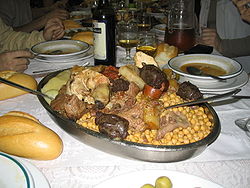- Cocido madrileño
-
Cocido madrileño 
Part of a cocido serving, with chickpeas, vegetables and meatOrigin Place of origin Spain Region or state Madrid Dish details Course served Appetiser or main course Serving temperature Hot Main ingredient(s) Chickpeas Cocido madrileño ("Madrilenian stew", Spanish pronunciation: [koˈθiðo maðɾiˈleɲo]) is a traditional chickpea-based stew from Madrid, Spain. A substantial dish prepared with meat and vegetables, it is most popular during the winter but is served throughout the year in some restaurants.
Contents
History
The origins of the dish are uncertain, but most sources agree[citation needed] that probably it was created during the Middle Ages as an evolution of the Sephardic dish adafina. Long cooking dishes were indispensable for Jews as they allowed hearty meals during Shabbat. These first versions were kosher, using eggs and without pork. Within time, adafina was soon popular elsewhere.
The growth of anti-Semitism and the Inquisition during the 15th and 16th centuries modified the dish substantially, as the fear of being denounced as Jewish forced Christians and Marranos (converted Jews) alike to prove themselves as Christians by incorporating pork into their meals. Soon lard, bacon, chorizo (pork sausage) and morcilla (blood sausage) were added to the dish.[1]
From these origins, the recipe allowed few modifications and was soon established as a staple of Madrid cuisine. During the growth of the city in the 19th and 20th centuries, its low cost and heartiness made it a popular order in small restaurants and the taverns catering to manual workers. After the Civil War, the austerity period, followed by the introduction of more convenient meals, reduced the public popularity of the dish.
Nowadays,cocido madrileño is mostly a homemade dish for special occasions. However, most artisanal restaurants in Madrid offer a version of cocido (especially on Tuesdays) and some traditional restaurants serve it daily as a speciality.
Ingredients
The main ingredient of cocido is the chickpea or garbanzo bean, preferibly of its larger variety (also known as kabuli). Vegetables are added: potatoes mainly, but also cabbage, carrots, and turnips. In some cases, green bean, mangold and cardoon is also added.
The meat used is fundamentally pork: pork belly, usually fresh, but sometimes cured (purists insist in even a point of rancidity); fresh (unsmoked) chorizo; onion morcilla, and dried and cured jamón serrano. Beef shank is also added; the fat content (flor) of the piece is highly prized. Chicken (specially old hens) is also part of the cocido.
Two bone pieces (ham bone and beef spine bone) are added to enrich the stock.
The final touch is the bola, a meatball-like mix of ground beef, bread crumbs, parsley and other spices, which, it is said, was created as a substitute of the eggs used in the adafaina.
On the table
Tradition rules that the ingredients of cocido must be served separately. Each serving is known as vuelco (overturn), as at each time the pot must be overturned to separate the ingredients.
The first vuelco is the soup: the stock of the cocido is drained and noodles are cooked on it. The second vuelco are the chickpeas and the vegetables. The third vuelco is the meat.
Some dishes are made with the leftovers of the cocido. Spanish croquettes are usually made with cocido stock for flavor. Ropa vieja is a fried mix of chickpeas and meat. Pringá is made with the fried meat leftovers and bread.
See also
- Stew
- Fabada asturiana
- Spanish cuisine
- Cozido
- Where to try cocido madrileño
References
Legume dishes 15 bean soup • Acarajé • Amanattō • Arroz con gandules • Avre Bendi • Baked beans • Bandeja paisa • Bap • Bean pie • Bean salad • Bigilla • Black peas • Bob chorba • Bouneschlupp • Burmese tofu • Caparrones • Cassoulet • Chana masala • Chapea • Cocido madrileño • Cowboy beans • Dal • Dal bati churma • Dal bhat • Dalcha • Deep-fried peanuts • Dhokla • Dilly beans • Doubles • Douzhi • Fabada Asturiana • Fabes con almejas • Falafel • Fasolada • Feijoada • Frijoles negros • Frijoles charros • Ful medames • Gallo pinto • Garnache • Gigandes plaki • Green bean casserole • Guernsey Bean Jar • Hoppin' John • Hummus • Jidou liangfen • Kongbap • Kuli-Kuli • Lablabi • Liangfen • Linsen mit Spätzle • Marrowfat peas • Masabcha • Matevž • Mjave lobio • Molagoottal • Mujaddara • Murukku • Mushy peas • Nokdumuk • Pabellón criollo • Panelle • Paripu • Pasta e fagioli • Pastizz • Pasulj • Pea soup • Peabutter • Pease pudding • Pie and peas • Pie floater • Platillo Moros y Cristianos • Pokhemma • Pork and beans • Porotos con rienda • Purtumute • Red bean cake • Red bean paste • Red bean soup • Red beans and rice • Refried beans • Revalenta arabica • Rice and beans • Rice and peas • Shahan ful • Shiro • Soup beans • Succotash • Tavče Gravče • Umngqusho • Yun dou juanCategories:- Culture in Madrid
- Spanish soups and stews
- Legume dishes
Wikimedia Foundation. 2010.


